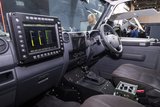US Army tests CBRNE detection systems
The US Army has tested new chemical, biological, radiological, nuclear and explosive (CBRNE) detection systems, the army announced on 30 May.
The Radiological Detection System (RDS) and Joint Personal Detector (JPD) devices are designed to increase the effectiveness and accuracy of CBRNE detection capabilities. The RDS is a portable sensor used to identify and classify threats, while the JPD is a wrist-mounted device that monitors radiation exposure levels.
The 20th CBRNE's Nuclear Disablement Team carried out an operational test to produce data on both units to inform senior army leaders on how effective, suitable and reliable RDS and JPD will be during real-world operations.
The equipment will improve soldier understanding of the radiological and nuclear (RN) environment through detection of RN threats, as well as provide a means to support the assessment of vulnerability to RN hazards in general.
The RDS is expected to replace the US Department of Defense’s legacy Radiation Detection and Computation survey meters as well as US Coast Guard, and other nations' legacy systems.
More from Digital Battlespace
-
![Babcock nears first customer for Nomad AI translation tool]()
Babcock nears first customer for Nomad AI translation tool
Nomad can provide militaries with real-time intelligence, saving critical time on the battlefield.
-
![AUSA 2025: Israel’s Asio Technologies to supply hundreds of improved Taurus tactical systems]()
AUSA 2025: Israel’s Asio Technologies to supply hundreds of improved Taurus tactical systems
Taurus operates alongside the Israel Defense Forces’ Orion system which supports mission management across tens of thousands of manoeuvring forces, from squad leaders to battalion commanders.
-
![AUSA 2025: Kopin pushes micro-LED plans as China moves faster]()
AUSA 2025: Kopin pushes micro-LED plans as China moves faster
The plan for the new displays follows fresh investment in Kopin’s European facilities by Theon and an order for head-up displays in fielded aircraft, with funding from the US Department of Defense.
-
![AUSA 2025: Persistent Systems to complete its largest order by year’s end]()
AUSA 2025: Persistent Systems to complete its largest order by year’s end
Persistent Systems received its largest ever single order for its MPU5 devices and other systems earlier this month and has already delivered the 50 units to the US Army’s 4th Infantry Division.
-
![Aselsan brings in dozens of companies and systems under the Steel Dome umbrella]()
Aselsan brings in dozens of companies and systems under the Steel Dome umbrella
Turkey has joined the family of countries attempting to establish a multilayered air defence system with government approval in August 2024 for the effort landed by Aselsan. Dubbed Steel Dome, the programme joins Israel’s Iron Dome, the US Golden Dome, India’s Mission Sudarshan Chakra and South Korea’s low-altitude missile defence system.
-
![DSEI 2025: MARSS unveils new agnostic multidomain C4 system]()
DSEI 2025: MARSS unveils new agnostic multidomain C4 system
MARSS’ NiDAR system has been deployed using sensors from static platforms to provide detection and protection for static sights, such as critical infrastructure, ports and military bases.




























